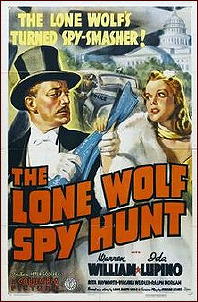January 2018
Monthly Archive
Mon 15 Jan 2018
Posted by Steve under
Reviews[7] Comments
BILL CRIDER – Of All Sad Words. Sheriff Dan Rhodes #15. St. Martin’s Press, hardcover, 2008. Worldwide, paperback, 2009.

This book also marks the first appearance in the series of C. P. (Seepy) Benton, a new-to-Blacklin County math teacher and would be folk singer whom Judge Parry warns Rhodes about as being a possible vigilante. True enough, after attending Rhodes’s “Citizens’ Academy,” Benton now believes that Rhodes could use a helping hand every so often, and that he, Benton, is just the man to give it.
Based on a real life friend of Bill’s, Benton joins the rest of the characters in Rhodes’s jurisdiction who continue to pop up in all of the books in the series, all vicarious friends of mine, and yours, too, if you’ve read as many of them as I have.
This one begins with the death of one of two dull-witted brothers suspected of running a meth lab in their mobile home which has exploded. Turns out that it wasn’t meth that they were working with, but a small full-blown still. Another death occurs before the book is over, and in the course of his investigation, Rhodes has plenty of bumps, scrapes and bruises to show for it.
While the mystery to be solved is a good one, even better is how well Bill Crider was able to make all of the people and places in this very enjoyable episode in Dan Rhodes’ career come to life — often in a quietly humorous way — but man, these are real people.
Sun 14 Jan 2018
Posted by Steve under
Reviews[7] Comments

AGATHA CHRISTIE – An Overdose of Death. Hercule Poirot #22. First published in the UK as One, Two, Buckle My Shoe (Collins Crime Club, hardcover, Nov 1940). First US edition published by Dodd Mead under the title The Patriotic Murders (hardcover, Feb 1941). Reprinted by Dell in the US in 1953 as An Overdose of Death. Many other reprint editions exist, in both hardcover and paperback.
The question is, why did a quiet, unassuming and otherwise quite unremarkable dentist commit suicide in the middle of the afternoon on a day no different than other day? When one of his morning’s patients is later found dead from an overdose of a numbing agent the dentist used, the police think they know.

Hercule Poirot is not so sure.
This is a beautifully constructed puzzle mystery, with patients for both the deceased dentist and his partner in and out all morning, with stairs, an elevator and a front door that may or not have been fully attended. Lots of suspects, in other words, with just as many motives and opportunities. This is as totally expected from a Christie novel of this time period. Not quite as expected is the political aspect of the story, with part of the story line involving left wing agitators speaking out against the conservative upper class who never want to change anything.
Does that have anything to do with the mystery and who did it? You’ll have to read this one for yourself. Christie is in very good form here, and while you may figure out the puzzle before Poirot does, I’m willing to wager you won’t. Either way, when I say “beautifully constructed,” I mean it. You will also be surprised how simple the explanation is. If nothing else, Christie was an absolute master of misdirection.
Sun 14 Jan 2018
REVIEWED BY BARRY GARDNER:

ROBERT CAMPBELL – The Wizard of La-La Land. Whistler #4. Pocket Books, hardcover, 1994. No paperback edition.
This is the first Whistler since Sweet La-La Land in 1990. Campbell is best known for his Jimmy Flannery books, but my favorite series of his consisted of two books about railroad detective Jake Hatch, Plugged Nickel and Red Cent.
Whistler, an ex-radio personality, a recovering alcoholic, and now a PI working the grungy streets of Hollywood, still remembers the unsolved murder of a cop friend’s young niece a decade ago. Now a young man dying of AIDS has whispered to a relative that he knows who did it, but hes murdered in his hospital bed before he names anyone. Old ghosts, new demons, and ever-present evil haunt Hollywood’s streets as Whistler tries to link past and present.
The Whistler books are among the darker of PI stories, and as a matter of fact remind me to mood and sometimes subject matter of Andrew Vachss. They are rough, hard books that deal with unpleasant subjects, written in terse prose to match. Whistler has never really come alive as a character to me, though Campbell does a creditable job with some supporting players. The narration if shifting third person, and Campbell is adept at telling his stories in this way. These are for only the hardest of hardboiled fans.
— Reprinted from
Ah Sweet Mysteries #14, August 1994.
The Whistler series —
1. In La-La Land We Trust (1986)
2. Alice in La-La Land (1987)
3. Sweet La-La Land (1990)
4. The Wizard of La-La Land (1995)
Sat 13 Jan 2018
REVIEWED BY JONATHAN LEWIS:
A SPECIAL DAY. Gold Film, Italy, 1977, as Una giornata particolare. Cinema 5, US, 1977 (subtitled). Sophia Loren, Marcello Mastroianni, John Vernon, Françoise Berd, Patrizia Basso, Tiziano De Persio. Director: Ettore Scola.

A Special Day is a very quiet film. It’s a film stripped down to its bare essentials. Two lead actors, one primary location, and a story that unfolds through dialogue. There’s not a lot of music and no special effects. And for the most part, this Golden Globe winner works in accomplishing what it sets out to do: to tell the story of two ordinary people trying to live authentically under the oppressive force of Italian fascism.
Filmed in a quasi-sepia tone, where the only notable colors are those of the Nazi and fascist flags, A Special Day isn’t a perfect film, but it’s a captivating one due in large part to its cinematography, direction, and its two legendary stars: Sophia Loren and Marco Mastroianni. The entire movie takes place on May 8, 1938, the day when Adolf Hitler visited Mussolini in Rome to solidify the alliance between Nazi Germany and Fascist Italy. It was a day of military parades and fascist spectacle.

Loren portrays Antonietta, a bored, listless Roman housewife with a husband (John Vernon) who doesn’t respect her and cheats on her with prostitutes. When she is left alone in the family apartment after everyone else goes to the parade for Hitler and Mussolini, a chance encounter leads her into the life of her quirky neighbor Gabriele (Mastroianni). He has decided not to attend the parade either.
As the story progresses, it turns out that both of them are suffering from extreme loneliness and that both have been living a lie. Antonietta is suffocating in her unhappy marriage and is not quite as enthusiastic for the fascist movement as she has publicly portrayed herself to be. And Gabriele has been removed from his position as a radio broadcaster for his homosexuality.

SPOILER ALERT! What the viewer doesn’t learn until the very end is that this is a “special†day for Gabriele in that he knows that evening he will be arrested and deported to an internment camp for his anti-fascist views and his homosexuality.
The story works best when it’s focused on the individual characters and their quirks and how their chance encounter changes the both of them. Little things such as Antonietta’s shame that she isn’t formally educated or Gabriele’s desire to learn the rumba give depth to their identities. There are some quite funny moments as well.
What doesn’t work as well is the film’s desire to deliver a message to the audience. Sometimes subtlety works better than hammering home a message that could have been delivered without some of the less believable moments, such as when Gabriele all but assaults Antonietta after she slaps him once he spurns her romantic advances.

And although the viewer sees Loren and Mastroianni, the film is supposed to be the story of a chance encounter between a conservative Italian housewife and an urbane, intellectual. Would these distinct personalities really bond in the emotional manner that they ultimately do in the film? Or is it pure theater and spectacle, a cinematic counterpart to the fascist narrative?
A Special Day works wonderfully in capturing the mood of how oppressive fascist Italy was for nonconformists, but does it in a manner that occasionally feels too forced and too reliant on its two leads to propel the movie forward when the script runs out of steam, which occurs after about an hour. But what two leads!
Fri 12 Jan 2018

NEW ORLEANS UNCENSORED. Columbia Pictures, 1955. Arthur Franz, Beverly Garland, Helene Stanton, Michael Ansara, Stacy Harris, Edwin Stafford Nelson, Mike Mazurki. Director: William Castle.
From the poster, you’d think that this movie would take place in and along Bourbon Street, with lots of gin joints, hot jazz, and girls in tight blouses and loose morals. Alas, it is not to be. This is a behind the scenes look at crime along the waterfront — smuggling, kickbacks, and petty pilfering, and as such, could have be told bout any large-sized port city in the US.

When Arthur Franz comes to town, he’s an innocent whose only goal is to fix up an old tub and go into the shipping business on the Mississippi for himself. In trying to make a go of it, his path crosses that of the big crime boss in person (Michael Ansara) and two women, one good (Helene Stanton), the other not so good (Beverly Garland).
I will not tell you which one he ends up with at the end of the movie, but I think perhaps you can guess as well I did. I cannot tell you more, as there is otherwise very little suspense in this film. Franz is OK as an actor, but as a leading man, he has very little charisma in this film. Another weakness in the casting is that Beverly Garland and Helene Stanton (The Big Combo) look too much alike, and while it was no chore watching either of them in action, it always took me a few seconds to distinguish which one was who, and even then I wasn’t always sure.
Fri 12 Jan 2018
CARLETON CARPENTER – Deadhead. Curtis, paperback original; 1974. Paperback reprint: Black Walnut, 1985.
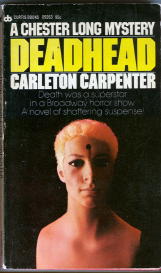
If you were to do a search for Mr. Carpenter on the Internet, you’d find more in the movie and entertainment databases than you will regarding his writing career, which consisted of only a small handful of paperback originals. There’ll be a list of them soon, in case you’re interested.
Before concentrating on the books, though, perhaps it suffices to say that Carleton Carpenter was a both a composer and an actor, in both the movies, on television and in Broadway musicals. One of the top musical hits of 1951 was “Aba Daba Honeymoon,†sung by Debbie Reynolds and Carleton Carpenter (from the film Two Weeks in Love). His career in the movies and on TV is summed up neatly at imdb.com (with some 42 credits as an actor).
Here’s a list of Mr. Carpenter’s mystery fiction. As previously mentioned all of these are paperback originals. * = Chester Long mysteries. ** = billed as a Jasper Wild mystery.
Games Murderers Play. Curtis 07271, 1973; Black Walnut, 1985.
Cat Got Your Tongue? Curtis 07272, 1973; Black Walnut, 1985.
* Only Her Hairdresser Knew… Curtis 07299, 1973; Black Walnut, 1985.
Pinecastle. Curtis 09187, 1973, as by Ivy Manchester; Black Walnut, as Stumped, as by Carleton Carpenter.
* Deadhead. Curtis 09263, 1974; Black Walnut, 1985.
** Sleight of Hand. Popular Library 00661, 1975; Black Walnut, as Sleight of Deadly Hand.
The Peabody Experience. Black Walnut, 1985.
Short story: “Second Banana.†Alfred Hitchcock’s Mystery Magazine, October 1976.
Little is known about Black Walnut Books, but they seem to have been in business only to print Mr. Carpenter’s books.
Whether Jasper Wild appeared in any of the earlier books or was intended to be another continuing character is also unknown. It would also be interesting to learn whether the AHMM short story has either Chester Long or Jasper Wild as characters, leading or incidental. Someone with access to that issue will have to let us know.

As you can see from the cover, Pinecastle (aka Stumped) was marketed and sold by Curtis as a gothic romance, but a quick scan through my copy indicates that the people who are in it all have a very strong theatrical background, which is not surprising.
Chester Long is a hairdresser (straight). Jasper Wild’s occupation is unknown. Someone who has a copy of Sleight of Hand will have to let us know. If by chance he’s a magician as well as a detective, that would be worth knowing.
As for the book at hand, Deadhead, when Chester is offered a position on the side as the head of the hairdresser crew for a musical bound for Broadway, he jumps at it. For the rest of the book he’s a fascinated observer behind the scenes, giving the reader an equally vicarious (and authentic) look at a world largely foreign to us mere mortals. Even so, as Chester admits on page 81:
In my heart I knew I was nothing more than a voyeur who was being overpaid for the opportunity to peep.
The going is as light and breezy as this for over 100 pages, chatty and gossipy in trunk loads. The murder of the show’s bizarrely flamboyant producer does not occur until page 104, which gives Chester the opportunity to show his flair as a sleuth. (Not that there’s any inkling of a previous criminous adventure. Until I checked out the bibliography, I was working under the impression that this was Chester’s first encounter with detective work.)
With the entire company on the road and snowed in as a mammoth snowstorm hits Boston, the effect is that of an isolated country house, which means, of course, besides clues and motives, means and opportunities galore.
And until the end, when things seem to fall apart plotwise, there would be much in the reading to recommend. While Carleton Carpenter is a story teller’s story teller, he unaccountably allows Chester’s previously mentioned flair as a sleuth to fizzle out well before the finale, all of his theories disappearing into smoke. On page 189, after the killer has been nabbed, and the case is being rehashed, Chester says:
This has been hindsight babbling on. I was just as surprised as anyone else.
In any case, all I can offer for a recommendation is hemi-semi-demi-positive one. The book is worth reading for the show business element – that part is simply Grade A all the way – but as a mystery, while it has its moments, the answer, if that’s what you’re asking, is, reluctantly, no. The cast and choreography are excellent, but the book itself? Good, but not up to par. It needs some work.
Thu 11 Jan 2018
REVIEWED BY WALTER ALBERT:
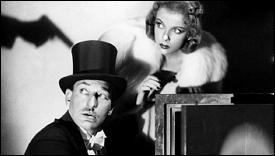
THE LONE WOLF SPY HUNT. Columbia, 1939. Warren William (Michael Lanyard), Ida Lupino, Rita Hayworth, Virginia Weidler, Ralph Morgan. Screenplay by Jonathan Latimer, based on the novel Red Masquerade (Doubleday, 1921) by Louis Joseph Vance. Director: Peter Godfrey. Shown at Cinevent 26, Columbus OH, May 1994.
Warren William is, as I have pointed out before, one of the great favorites of film convention audiences (both Cinevent and Cinefest), so his stint in The Lone Wolf Spy Hunt was eagerly awaited by the conventioneers. Well, everybody has an off day, and it appeared to me that Williams’ dapper suavity was showing its age and formulaic quality here.
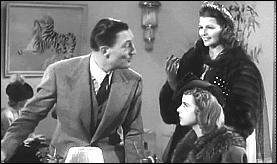
He was not helped by co-star Ida Lupino, an intelligent actress requited to throw ignored girl friend fits that were noisy but sour rather than funny or wry. Lupino was uneven as an actress, sometimes betrayed by her natural ability to command attention whatever she did, even when it seemed out of key with the movie.
Virginia Weidler was arch as Williams’s precocious daughter (a role she patented in The Philadelphia Story), although the writer of the program notes thought her “delightful.” A reminder that not all “B” movies were little gems.
Wed 10 Jan 2018
Posted by Steve under
Magazines ,
Reviews1 Comment
Reviewed by MIKE TOONEY:
(Give Me That) OLD-TIME DETECTION. Issue #46. Autumn 2017. Editor: Arthur Vidro. 36 pages. Published three times a year: Spring, Summer, and Autumn. Sample copy: $6.00 in the U.S.; $10.00 anywhere else.
The latest issue of Old-Time Detection is here, and it’s definitely worth a look, as it’s full to the brim with information and insights about detective fiction’s Golden Age (and beyond).
J. Randolph Cox has a biographical sketch of A.E.W. Mason, remembered today more for his general fiction than his mysteries (“[In the character of Hanaud] Mason seems to have wanted to create a professional detective who was unlike Sherlock Holmes, a man who was genial and friendly and willing to trust his intuition. Hanaud is all of these but is never described explicity. He is revealed by his actions, as an actor in a play is revealed”).
Dr. John Curran keeps us up to date with the latest doings in the ever-expanding Agatha Christie universe (“This year’s [Agatha Christie] Festival was, sadly, a disappointment”).
Jon L. Breen offers expert opinions about authors who were hot in the early ’80s (“This is a worthy sequel because of its freshly-minted bamboozlement”).
Francis M. Nevins gives us a fine overview of the life and times of uber-reviewer Anthony Boucher, a genius in any field he chose to explore (“At two the next morning she [Lee Wright] woke up her husband with the excited cry that she had just found the first unsolicited manuscript she ever wanted to publish”).
Michael Dirda has recommendations for those chilly evenings when TV isn’t spooky enough (“Even if you’re snowed in for the holidays — or all of January, for that matter — these collections will keep you cozy”).
Charles Shibuk reveals the pleasures to be found in paperback reprints (“… the best reprint period I have seen in many years”), but notes the sad decline of a detective fiction legend (“Gone is the mastery of plot and puzzle, the spinning of deceptive clues, the sharp and incisive descriptions and dialogue”).
Dennis Drabelle highlights the late P. D. James’s short mystery fiction, something she seldom produced (“The four tales in this slim volume, then, are old-fashioned, at least up to a point: no noir, yet plenty of shadows; no explicit sex, but ample erotic tension. And James spins them with the economy demanded by the short form”).
… and, to top it all off, editor Arthur Vidro offers up a typically fine puzzler by William Brittain originally from EQMM (“The man in the comic strip. He walked right up the alley there just when the men came out of the bank, and touched them with his electric hands. And then he took them back down the alley”).
You can subscribe to Old-Time Detection, by contacting the editor at: Arthur Vidro, Old-Time Detection, 2 Ellery Street, Claremont, New Hampshire 03743 or oldtimedetection@netzero.net.
Tue 9 Jan 2018
A 1001 MIDNIGHTS Review
by Robert E. Briney
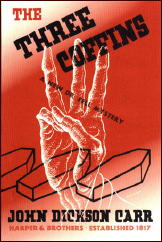
JOHN DICKSON CARR – The Three Coffins. Dr. Gideon Fell #6. Harper & Brothers, US, hardcover, 1935. Published in the UK by H. Hamilton under the title The Hollow Man hardcover, 1935. Reprinted many times, in both hardcover and soft.
In this Dr. Fell novel, one of the most intricate in the series, the author loses no time in making his intentions clear. In the very first paragraph, two impossible crimes are announced: a locked-room murder and what might be called a “locked-street” murder.
The victim in the first crime is Professor Charles Grimaud, a lecturer and writer of independent means, whose habit it is to visit a local pub every evening and hold forth to a fascinated audience on magic, the supernatural, vampirism, the Black Mass, and similar topics. One evening the professor’s lecture is interrupted by a man who identifies himself as Pierre Fley, “Illusionist.”

Although he tries to hide the fact, the professor is terrified by Fley’s cryptically threatening remarks. Some days later, Grimaud is in his study at home when a mysterious visitor arrives, forces his way into the room, and locks the door. The door is thereafter under constant observation; the room has no other exits and no hiding places. A shot is heard, and when the door is forced, Grimaud is found alone in the room, dying of a gunshot wound. His visitor has vanished.
On that same evening, some distance away, Fley is also shot to death. The crime takes place in the middle of an empty, snow-covered street, with watchers at either end; yet no one sees the murderer, and there are no footprints in the snow.
It quickly develops that Grimaud and Fley shared a deadly secret, with roots going back to tum-of-the-century Hungary. This connection from the past provides the book’s title: Fley once told an acquaintance, “Three of us were once buried alive. Only one escaped.” When asked how he had escaped, he answered calmly, “I didn’t, you see. I was one of the two who did not escape.”

It also supplies the motive for the crimes. But Fell must delve into more-modern relationships and unravel some subtle trickery in order to explain the apparently impossible circumstances of the crimes and identify the guilty. When the last piece of the puzzle has fallen into place, with an extra twist in the concluding lines of the book, Fell says, “I have committed another crime, Hadley. I have guessed the truth again.”
Chapter 17 of the novel has become famous among mystery enthusiasts, and has been reprinted separately. It is “The Locked Room Lecture,” in which Fell systematically classifies the principal types of locked-room situations. Other writers — notably Anthony Boucher and Clayton Rawson — later added to this discussion, and many others have profited from it in constructing their own plot devices.

This chapter also contains a comment that has disconcerted more than one reader. When Fell brings the topic of detective fiction into his analysis of impossible situations, he is asked why he does so. “‘Because,’ said the doctor frankly, ‘we’re in a detective story, and we don’t fool the reader by pretending we’re not. Let’s not invent elaborate excuses to drag in a discussion of detective stories. Let’s candidly glory in the noblest pursuits possible to characters in a book.'”
The device of having a character acknowledge that he is a fictional character and comment on the fact has been used more than once in “high” literature. For Carr, it was simply part of playing the game — “the grandest game in the world” — with his readers, and for those readers willing to enter into the spirit of the game, it is a clever and charming touch.
———
Reprinted with permission from 1001 Midnights, edited by Bill Pronzini & Marcia Muller and published by The Battered Silicon Dispatch Box, 2007. Copyright © 1986, 2007 by the Pronzini-Muller Family Trust.
Tue 9 Jan 2018
Posted by Steve under
Reviews[3] Comments
REVIEWED BY BARRY GARDNER:
REGINALD HILL – Pictures of Perfection. Dalziel & Pascoe #14. Harper Collins, UK, hardcover, 1994. Delacorte, US, hardcover, 1994. Dell, US, paperback, 1995.

A rather officious young polilcemann has gone missing in the Yorkshire town of Enscombe, or at least his immediate superior thinks he has. Dalziel isn’t at all sure there’s anything wrong, but nevertheless dispatches Pascoe and Sergeant Wield to check into things.
Beneath the semi-placid surface of the village several potentially hazardous are fermenting away among the locals, the Squire and his family, and all sorts of people. The policeman is indeed missing, but the hows, whys, and wheres remain elusive.
Reginald Hill is assured a place in my heart if for no other reason than this line referring to the 80s: “But they were not long, the days of swine and Porsches.” Priceless. Hill to my eye is one of the finest prose stylists working today in any discipline.
He is also one of the best at delineating character. Not just his regulars — the choleric and canny Dalziel, the intense and intelligent Pascoe, the gay Sergeant with the gargoyle face Wield — but also the people into whose lives they are thrust.
Wield somewhat takes center stage here, thous as usual Hill tells his story from many viewpoints. The book begins with a man running amok with a gun, and ends in a way that I think will surprise you. Hill certainly intends for it to, anyway.
— Reprinted from
Ah Sweet Mysteries #14, August 1994.
« Previous Page — Next Page »



